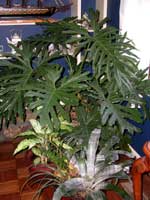Resource Library
Plant of the Week: Tree Philodendron
The University of Arkansas System Division of Agriculture does not promote, support or recommend plants featured in "Plant of the Week." Please consult your local Extension office for plants suitable for your region.
Plant of the Week
Tree Philodendron
Latin: Philodendron bipinnatifidum

I’ve been lugging a tree philodendron in and out of the house for so many years, I can no longer remember where it came from. As a houseplant, it has an adaptable soul, surviving all manner of abuse and neglect. If it didn’t weigh so much, I think I’d appreciate it more.
Tree philodendron (P. bipinnatifidum, but until recently known as P. selloum) is native to southern Brazil and adjacent areas of Argentina, Bolivia and Paraguay. In its native habit, it often grows along rivers at the edge of the tropical forest.
Plants develop a single, unbranched, 4-inch diameter trunk supported by long, dangling rope-like roots that restrict as the plant grows to provide tight anchorage. Stems can reach 8 feet or more in height. In nature, these tall stems eventually snuggle up to a tree trunk and the aerial roots anchor themselves to the bark, permitting the ongoing quest for light.
The enormous leaves are the real attraction for the plant. Mine has leaves 30 inches long and 24 inches wide, each half of the leaf dissected into eight to ten prominent lobes. The leaves are produced at the ends of the slowly elongating trunks and are held outwards on three foot long petioles. Given a larger pot or if grown in the ground, tree philodendron leaves can be considerably larger.
Tree philodendrons are grown from seed in the nursery industry, usually with three or five seedlings used together in the pot. Juvenile leaves have a wavy margin and little resemble the adult leaves. Flowers are seldom seen in captivity and are not especially beautiful when they do occur on older specimens. But their flowering mechanism is interesting and provides an example of co-evolution.
Unlike most other plants, members of the arum family, to which the tree philodendron belongs, come into heat when they bloom. We’re not talking about just a little heat either. In the case of the tree philodendron, the bloom (the spadix) shows a temperature rise of around 18 degrees Fahrenheit above the surrounding air temperature when the flower first opens.
But come nightfall (about 7 pm), the hormones kick in and the need for love really increases. The temperature begins to rise and the spadix temperatures spikes somewhere between 95 and 115 degrees Fahrenheit.
Though it lasts only about two hours, it usually accomplishes its intended goal, attracting hundreds of large scarab beetles that do the pollination. The heat, generated by rapid metabolism of stored lipids, volatilizes a pungent attractant described as having an odor of “a mixture of black pepper, cinnamon, vanilla and a resinous compound.”
Tree philodendrons grow in bright light conditions and thrive outside on the patio during summer. But surprisingly, it tolerates low light conditions inside during the winter. I limit mine to a 12 inch pot, the maximum size I am willing to lift. If a bigger pot were used, the plant would get larger but, in the process become almost impossible to move. It’s not fussy about water or humidity requirements. Slack off on watering in the winter and water more during the brighter, hotter days of summer.
Tree philodendrons are most attractive when they’re small. Small is relative, because in their most attractive form they will be 3 or 4 feet tall with a wingspan of 5 or 6 feet. But, as the trunks begin elongating, they get a bit ugly. They have a reputation of not branching very well when cut back, but I cared for a big, sprawling specimen that took over a corner of a greenhouse. When it was cut back, it branched from near the base of the stem. The terminal shoot, with a couple leaves attached, can be potted into a large pot where it will root.
By: Gerald Klingaman, retired
Extension Horticulturist - Ornamentals
Extension News - January 13, 2006
The University of Arkansas System Division of Agriculture does not maintain lists of retail outlets where these plants can be purchased. Please check your local nursery or other retail outlets to ask about the availability of these plants for your growing area.